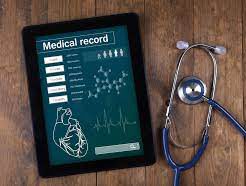Electronic Health Records (EHR) is a current rising necessity in health systems. EHR was initially used for improving the health services but now is gaining importance & used for improving public health & better population health outcomes. The interoperability & sharing of the EHR in real time across different actors is bringing positive differences explicitly. In today’s time of pandemic, EHR has gained the large aspect of utilisation in improving various social determinants outside health services. With constant changes across international borders & travel rules like quarantine & increased risk of covid-19 transmission while travelling across different regions, states & countries; the patients have also become global rather than national. In such conditions, the front end EHR data entered by the doctors & healthcare workers on health status, imaging, scans, and disease history can be shared instantly. These EHRs are not only beneficial at individual level but also it helps in assessing the risks at population level & strategizing health policies for improving population health outcomes. Hence, EHRs are useful in improving public health information and surveillance (HealthIT.Gov, 2019). EHRs are also a useful tool for research & evidence purposes because EHRs acts as a huge repository for disease & treatment records that help in identifying the effectiveness, quality, and outcomes of certain treatment plans & clinical interventions (Denny, J. C., 2012). In recent years, EHRs are widely used as a broad tool for genetic analysis in clinical research (Denny, J. C., 2012). The use of EHRs is not only limited to research, health services & population health outcomes but it is also an important tool in measuring health system performances. The appropriate set of domains in health system can leverage the EHR’s benefits in improving patient safety. Evidence suggests that EHRs in comparison to the paper records, helps in patient safety via measuring domains of “medication management, handoffs and transition, personnel qualifications and competencies, practice management and culture, and patient communication” (Tanner et al., 2015). The emerging “socioecological model” of EHRs in health addresses the factors interacting outside healthcare of technology with patient safety, research, treatment & medication records, and health communications (Tanner et al., 2015). The added benefits of using EHRs like less time consuming, less complex, easy to maintain & retrieve, enhanced collection of patients social & behavioural records along with medical records and less expensive are boon for health systems.
Despite the benefits of EHRs in improving population health outcomes, there are certain set of challenges that limits its benefits. One of the key limitations of EHRs are the regulations of it in terms of data privacy, data sharing & use of the accessed data (for ethical reasons). In some countries the access to the EHRs is easy whereas in some countries the access is complex, challenging & tough hence limiting the potential use of EHRs in research, health policy implications and assessing the health systems effectively (Casey et al., 2016). Another most common challenge in EHR is the adaptability of it by the workforce in terms of the training & education of EHRs to its full potential in a structured way (Madhavan et al., 2020). The evidence suggests that adoption rate for EHRs is still low due to lack of training, learning & confidence in using EHRs (Ajami & Bagheri-Tadi, 2013). A structured systematic approach in use & adoption of EHRs through short trainings modules from time to time helps the doctors & health workers to feel confident & remain UpToDate with the EHRs (Ajami & Bagheri-Tadi, 2013).There is a need for congruent engagement of IT team, public health team, doctors , epidemiologist , government , private and NGOs from time to time in order to maximise the benefits of EHRs for improving population health outcomes & strengthening the health systems (Madhavan et al., 2020). EHRs which was a growing opportunity in the past has now become a necessity globally after the pandemic. Hence it is important for global, national & international actors to leverage the benefits of EHRs to maximum for effective health policy decision making & ameliorating health outcomes.
To conclude, although the benefits of EHRs outweighs the limitations, abstaining to address the limitations acts a barrier in maximising the benefits of EHRs. In today’s time of pandemic, the use of EHRs has become a global necessity for strategizing health policies, strengthening health systems and impacts the population health outcomes.
About the author: “Dr Darshita Singh is currently pursuing masters in Global Health Policy at The London School of Economics and Political Sciences,LSE,London with experience in digital health , healthcare services and public health projects in the past . “
References
- How can electronic health records improve public and population health outcomes? | HealthIT.gov. (2019). Retrieved April 30, 2022, from https://www.healthit.gov/faq/how-can-electronic-health-records-improve-public-and-population-health-outcomes
- Denny, J. C. (2012). Chapter 13: Mining electronic health records in the genomics era. PLoS Computational Biology, 8(12), e1002823. https://doi.org/10.1371/journal.pcbi.1002823
- Tanner, C., Gans, D., White, J., Nath, R., & Pohl, J. (2015). Electronic Health Records and Patient Safety. Applied Clinical Informatics, 6(1), 136–147. https://doi.org/10.4338/ACI-2014-11-RA-0099
- Casey, J. A., Schwartz, B. S., Stewart, W. F., & Adler, N. E. (2016). Using Electronic Health Records for Population Health Research: A Review of Methods and Applications. Annual Review of Public Health, 37, 61–81. https://doi.org/10.1146/annurev-publhealth-032315-021353
- Madhavan, S., Bastarache, L., Brown, J. S., Butte, A. J., Dorr, D. A., Embi, P. J., Friedman, C. P., Johnson, K. B., Moore, J. H., Kohane, I. S., Payne, P. R. O., Tenenbaum, J. D., Weiner, M. G., Wilcox, A. B., & Ohno-Machado, L. (2020). Use of electronic health records to support a public health response to the COVID-19 pandemic in the United States: A perspective from 15 academic medical centers. Journal of the American Medical Informatics Association: JAMIA, 28(2), 393–401. https://doi.org/10.1093/jamia/ocaa287
Ajami, S., & Bagheri-Tadi, T. (2013). Barriers for Adopting Electronic Health Records (EHRs) by Physicians. Acta Informatica Medica, 21(2), 129–134. https://doi.org/10.5455/aim.2013.21.129-134
-
ECIPHhttps://eciph.in/author/eciph/
-
ECIPHhttps://eciph.in/author/eciph/
-
ECIPHhttps://eciph.in/author/eciph/
-
ECIPHhttps://eciph.in/author/eciph/




